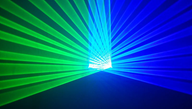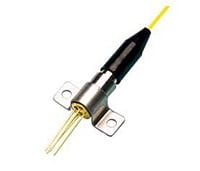
Once thought to be impossible, blue, green and UV laser diodes have now become commonplace. These lasers are being used in a wide range of applications from blue-ray players to commercial lighting & displays to copper welding. In this post, we are going to take a look at the underlying material properties of semiconductors, GaN in particular, and how it has led to the development of green, UV, and blue laser diodes.
What is Gallium Nitride?
Gallium nitride (GaN) is a rather hard, binary III/V direct bandgap semiconductor exhibiting a Wurtzite crystal structure with a high level of mechanical stability. GaN crystals can be commercially grown using molecular beam epitaxy or metalorganic vapor phase epitaxial (MOVPE) growth, which is also known as metalorganic chemical vapor deposition (MOCVD). Due to this material’s relatively wide bandgap energy of 3.4 eV, GaN is ideal for the production of semiconductor optoelectronic devices, producing blue wavelength light without the need for nonlinear crystal harmonic generation. Since the mid-’90s, GaN substrates have been the common material utilized for blue light emitting diodes (LEDs). In more recent years, GaN laser technology has provided blue, green and UV laser diode wavelengths to many industries.
Gallium Nitride Semiconductor – Bandgap Energy and Wavelength
Before we can get into the specifics of Gallium Nitride Laser Diodes, it’s important to remember that the output wavelength of a semiconductor laser is based on the difference in energy between the valance and conduction bands of the material. This energy difference, known as the bandgap energy (shown in the figure below), determines the photon energy. Since the energy of a photon is inversely proportional to its wavelength, this means that a larger bandgap energy will result in a shorter emission wavelength.
Semiconductor devices can be engineered to have a specific bandgap energy by combining various elements to form binary, ternary, and quaternary alloys. These semiconductors can have their bandgap further tailored, varying the stoichiometry in ternary and quaternary semiconductors. In our specific case, visible laser diodes can be produced from a combination of nitride materials, such as aluminum nitride (AlN), GaN, and indium nitride (InN), creating AlGaN and InGaN laser diodes for example. The resultant alloy, typically referred to as simply ‘GaN’ in shorthand, can theoretically be combined using the following formulas AlxGa1−xN and AlxInyGa1−x-yN to form any bandgap which falls within the “banana,” shown in the figure below.
The Green, Blue & UV Laser Diode Revolution
In practice, the material science involved in stably producing laser diode structures with any arbitrary stoichiometry is far more challenging. As stated earlier, for many years it was thought that these challenges would never be overcome, until 1996 when the first AlGaN laser diode was invented by Shuji Nakamura. Nakamura’s work with GaN based semiconductor lasers and LEDs was so revolutionary that he was later awarded the Nobel prize in physics. Over the past 20 years, the technology for making Gallium Nitride (GaN) Laser Diodes has matured into its own branch of optoelectronics. These laser diodes are now available in wavelengths from 375 nm to 521 nm, with output powers exceeding 100 watts.
How Can We Help?
Here at RPMC, we are proud to represent several of the leading manufacturers of high quality GaN based lasers diodes. We offer a wide assortment of multimode laser diodes, with a wide range of output powers, in 375 nm, 405 nm, 445 nm, and 520 nm wavelength options, as well as single-mode laser diodes in 405 nm, 420 nm, 425 nm, 430 nm, 435 nm, 440 nm, 445 nm, 450 nm, 455 nm, 460 nm, 480 nm, 488 nm, 495 nm, 505 nm, and 520 nm wavelength options. Within our GaN based laser diode selection, we have options for both free-space and fiber-coupled packaging, including various TO-Can packages, HHL packages, and fiber-coupled butterfly packages. Furthermore, most of our laser products allow for optional packaging and specifications, as well as some form of customization. If you don’t see exactly what you are looking for, let us know. Whether your performing laboratory testing or have specific requirements for an OEM laser diode source, we can likely figure out a quick and easy solution to meet your exact requirements.
For detailed technical specifications on our UV, blue, and green laser diodes click the button below or talk to one of our laser experts today by Contacting Us with the button below, or by emailing us at [email protected]!
Have questions?
See Our GaN-Based Laser Diode Options!
Additionally, if you want to learn more about laser fundamentals check out our Lasers 101 laser selection guide.

 SHIPS TODAY
SHIPS TODAY 


